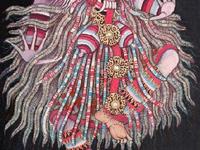
Mondays and Wednesdays 3 - 5 PM
Or by appointment at 203.432.0670
Puppets and Performing Arts of South and Southeast Asia
Curated by Kathy Foley
In South and Southeast Asia paintings, puppets, and theatre often are part of religious traditions that make the divine in both its beneficent and demonic forms visible in the world. This selection of objects focuses on extremes of the peaceful and the terrible manifestations of the sacred. In the tantric strains, which suffuse the performing arts of the region, shared by Hindu, Buddhist, and Islamic culture groups the good and the terrible forces may be complimentary sides of the same energy. The power is otherworldly, but humans also participate. The same figure will often have a peaceful and a terrible form.
Part of theatre’s job is to make sacred insights accessible to all viewers, regardless of class. Imagery from teyyam of Kerala, India and Rangda-Barong mask theatre of Bali may be related to early cults with shamanic, chthonic roots. Performers in such genres can go into trance—costume, make-up, and mask are crucial to the practice.
Striking outfits and extreme make-up transform the human. The aesthetic of trance genres influence puppet makers and actors who want to show the spirit energy. This may explain the impressive iconography and enlarged figures in the theatrical forms. The great stories—the Ramayana and Mahabharata, the tales of Lord Krishna (an avatar of the God Vishnu), Amir Hamzah (the uncle of the Prophet Mohammed) and other tales—show the interactions of the divine and human. Human heroes participate in divine energy.
Tales may be presented in simple form by a single narrator/dancer or puppeteer using music, word, and dance and the story helps ordinary people learn in a visceral way the religious truths. The solo narrator/puppeteer/actor plays both the human and the divine characters and he/she reminds viewers that the microcosmic and macrocosmic forces are linked. Multi-person troupes may emerge, but often keep a narrator/singer to lead the story. Actors are like images or puppets moving under the narrator’s direction.
Sufi forms of Islam in India or Java may interpret related ideas in a more abstract and mystical way than the Hindu and/or Buddhist areas (India, Cambodia, Thailand, Bali) where the tales may be seen by some as literal happenings of the past—comparable to the way some Westerners see the Bible.
The pattern of displaying the extremes of divine and demonic in the visual and performing arts is shared across the South and Southeast Asian region. These theatres, while dealing with very realistic emotions and situations, place our humanity in a continuum that extends beyond. Once we can understand how we participate in and shape the demonic and divine, our vision is expanded, and we ourselves abjure the demonic and cleave to beneficent cosmic energy.
There will be a reception/vernissage with the curator on Tuesday, April 8 at 4:30 PM.
Acknowledgements: Yale Institute of Sacred Music, Karen Smith, Marlene Pitkow, Diana Daugherty, Michael Schuster/East West Center, Phyllis Granoff, Martin Jean, Mark Bauer and Whitney Humanities Center Gallery, James Gunderson, Amy Trompetter, and UCSC Arts Research Institute and Committee on Research.
A collaborative presentation of Yale Institute of Sacred Music, Whitney Humanities Center, and the Department of Religious Studies